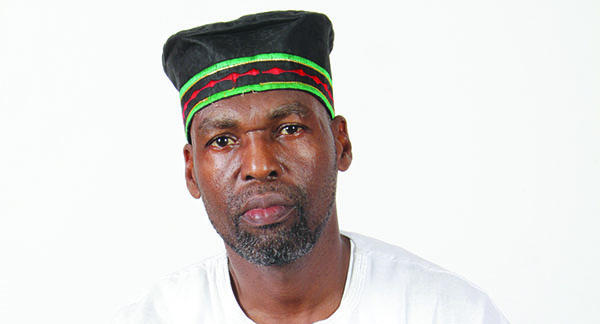Photo above is of Yaw Akyeaw.
By Neil Armstrong
Pride Contributing Writer
TORONTO, Ontario – Twenty-five years after the Into the Heart of Africa exhibition at the Royal Ontario Museum (ROM), the pain is still palpable in the memory of those who protested against it, but they are engaging the museum in a new project that draws from lessons learned and presents Africa and the African Diaspora differently.
Of Africa, Histories Collections Reflections, a three-year multi-platform project exploring African experiences through exhibitions, lectures, performances and events, opened at the ROM recently with reflections from two of the people instrumental in the protest, scholar, historian and poet Dr. Afua Cooper and Ras Rico.
Into the Heart of Africa, the first exhibition of African art at the ROM drawn from the museum’s ethnographic collections, opened in November 1989 and ended in August 1990 after much protest by the Committee for the Truth About Africa (CFTA).
At an opening reception of Of Africa, Cooper reflected on how the committee members were portrayed in the media and the backlash that resulted in some being blacklisted.
They experienced much difficulty finding employment, and in one case, Adisa Oji, was imprisoned for six months, could not travel to the U.S. and had his teaching career stymied. He now lives in Ghana and Canada where he runs his business, MACPRI and is a developer of the African Image Revolution.
Ras Rico, now living in Winnipeg, said the museum learned from the protest since then but he wondered what had the community benefitted from the ROM and how would the event be viewed in years to come.
Their comments followed opening remarks by Janet Carding, director and CEO of the ROM, at the event entitled “Acknowledging the Past. Forging the Future.”
“Twenty five years ago, the ROM opened “Into the Heart of Africa”. The exhibition and protests that followed represent a painful chapter in the ROM’s one hundred year history. Into the Heart of Africa brought to light the problematic colonial premises on which museums were established and the consequent difficulty in engaging effectively with Canada’s diverse communities. On reflection, the ROM during this time did not address the important issues of inclusiveness and representation brought to the fore by the protesters. To quote the Canadian poet, novelist and writer M. NourbeSe Phillip, the ROM remained ‘a museum of silence’,” said Carding.
She said those events were a pivotal experience for the ROM and forever transformed the way it and museums around the world now engage, collaborate and partner with communities.
“This deep change is now reflected in the core of every exhibit, event and program that we plan and bring to life for visitors. Tonight is an opportunity to reflect and acknowledge our past. And, it is a chance to show the ROM of today–a very different museum from the one of twenty-five years ago.”
A two-day symposium on October 24 and 25 opened with a roundtable discussion, “Learning from Into the Heart of Africa,” featuring Afua Cooper, Geraldine Moriba, and “Yaw” Oluwasanjo Akyeaw – all were members of CFTA — and Dan Rahimi, a former curator at the ROM who worked there during the exhibition and protest.
Moderator, Honor Ford-Smith, in her introduction of the discussion said, “the histories we have come here to remember have had real consequences to the bodies of many people in this city and beyond.” She started the event by recognizing all those in the audience who participated in the protest or who supported it twenty-five years ago.
“At the opening of this conference we heard much about participation. Participation is important but it also has to translate into power. Reconciliation is important but it is not the same as reparation. What we talk today is about the consequences of the struggle for those who were involved in it and those who will bear the benefits of its legacy. We need to talk perhaps beyond participation and to think about the ways that memorialization will help us to imagine reparation at multiple levels, both inside and outside of the museums,” she said.
Providing the historical context of the protest, Dr. Cooper showed the first image that a visitor to the ROM saw when they entered the Into the Heart of Africa exhibition. It was Lord Beresford’s encounter with a Zulu, something that was printed in the London News, 1879.
“It speaks to the so-called “pacification” of Africa, of southern Africa, in particular, of what is now South Africa, to be more specific, and the resistance of indigenous peoples to European colonialism and imperialism,” she said.
Twenty-five years ago, 1989-1990, she was finishing up a Masters degree in History at the University of Toronto, on the black communities of Ontario, looking at education and community building.
She went to see the Into the Heart of Africa exhibition and as an African history scholar was “particularly disturbed” by what she saw.
“The name of the exhibit itself, for me, gave me a feeling of disquiet, maybe outrage is probably a more accurate word. The exhibit was called “Into the Heart of Africa” and of course, what is that? There are echoes of Joseph Conrad’s “Into the Heart of Darkness” so for people of a certain education, going in, already you have – Honor spoke about the unconscious resonance of particular histories – and sometimes we’re not even sure of what’s going on in our psyche.”
She said in light of what was happening in the city – the struggles with the police, shootings, the disenfranchisement of young people – she continued into the exhibit and became more outraged and angry.
Dr. Cooper said the worldview of Africa that was presented was “Africa as childlike, primitive, savage and in need of European tutelage. This Black primitivism and the exhibit, where the images and accompanying text are online, so you can look at it. This Black primitivism juxtaposed with the white man and also the white woman’s burden written large.”
She said this revealed Canada’s imperial and colonial world in so-called tropical Africa as missionaries, especially missionaries, soldiers and colonial adventurers, journeyed to Africa and carried out all kinds of activities and got the objects.
After seeing the exhibit, a group of students from the university met and out of that came the Committee for the Truth About Africa (CFTA) which was composed of diverse groups and people, and individuals from the Black community and other communities. The committee was made up of Muslims, Christians, Rastas, communists and atheists, among others.
The historian said this was contrary to what the media said at the time, “that we were a bunch of ragtag ignorant students.”
She said they presented a counternarrative to the official story but the status quo, media, police force and other mainstream institutions supported the museum.
They started off by writing letters, petitions and making phone calls which did not make an impact and later met with some members of the ROM as the protest intensified.
The committee decided to picket every Saturday, in front of the museum, with banners, placards and posters. This soon led to a court injunction by the ROM to keep protesters from picketing within 15 metres of the entrance.
There was a confrontation with the police in which Cooper remembers twenty-five police vehicles, including swat cars, being parked in front of the ROM.
The “ROM 11” – eleven people who were arrested and charged with destruction of property and other charges – were hauled before the courts.
Cooper said there was severe media backlash, which saw protestors being painted as lunatics, stupid people, and even terrorists.
The CFTA had a list of demands that was presented to the ROM then which asked for equity in hiring.
“We said to the ROM, we want to see Black people in the ROM as curators, having important positions who would be decision makers, not somebody who is going to be hired for six months and then is gone. Because in order to challenge white supremacy in crucial ways, you have to have a structural change,” Cooper said, noting that it is a current issue twenty-five years later.
Fast forward to 2014, Cooper said “we are still dealing with how Africa is presented in mainstream institutions, in this case, in the media — entire continent, as in the case of Ebola, entire continent’s image, economy affected by fears of Ebola.”
The James Robinson Johnston Chair in Black Studies at Dalhousie University said it is incredible that there are people with university degrees who still think that Africa is like the size of Halifax, Nova Scotia.
Moriba, an Emmy award-winning producer and vice president of diversity and inclusion for CNN Worldwide, was an undergraduate student at the University of Western Ontario at the time of the protest, and in her presentation examined media reports about CFTA.
“What’s amazing about what we accomplished twenty-five years ago is that we did it without social media. We did it without the help of computers. That was only twenty-five years ago and there were no computers. We had personal computers but we weren’t connected by the Internet. We had fax machines and what we did was type letters and press releases late at night/early in the morning and we sent them off via fax machines, on our bicycles dropping them off at every media outlet we could think of,” Moriba said.
She highlighted the bias against the protestors in media reports which depicted them as violent and terrorists.
“We were none of those things. When we went out on Saturday mornings to protest we went with our families.”
Moriba said at the time of the ROM protest there was a protest against Philippe Rushton, a professor of psychology, on her own campus who was teaching that intelligence was inversely proportional to genitalia. There were also protests against apartheid in South Africa.
She said the ROM protest grew in numbers and there were even students of the curator, Jeanne Cannizzo, who were not members of CFTA, who protested in her classroom calling her racist.
Some people also protested in front of her home, whom Moriba said, had no connection whatsoever with CFTA.
Moriba said the archives are all there and unfortunately this in how history is recorded.
“Many, many years from now, there will be future generations, there will be some scholar who says I want to look into this and the first thing they will do will be, unfortunately, to pull up these articles and they’ll get a very one-sided depiction. As a journalist, I feel shame. It has to change and I know in my own world, in my own existence I try to do the little I can where I am but it will take much more.”
Rahimi is the executive director of Galleries at the University of Pennsylvania Museum of Archaeology and Anthropology. He was formerly vice president, program, at the ROM.
He described the police presence at the protest as provocative and said he thought Cannizzo, as curator, was not the one to be called out because she worked for the ROM.
“And it’s the ROM itself, I think, that made this terrible mistake in this exhibition. Although Jeanne was largely the author of it, it’s the museum itself that has to bear the responsibility for it.”
He said after Into the Heart of Africa, he started to get more involved in the development of galleries and in exhibitions.
“Soon after the exhibition closed, I think the ROM was a bit shell shocked. The exhibition was designed as a traveling exhibition, it was supposed to go to three other Canadian museums, all of whom cancelled. The ROM didn’t cancel the show but the three other museums said, “No thank you, we don’t want that show any longer.” And, it represented a financial failure, which I think the ROM was concerned about, but much more than that it was a museological and, I think, a moral failure.”
Rahimi said the ROM regrouped and started to consider to build exhibitions and galleries, and work with communities to do this.
He also said the ROM now has a curator of African art, Silivia Forni, a new position at the museum which is a commitment from the ROM on studying and displaying African art and exhibitions.
Referencing the CFTA’s demand in 1989 that the ROM change its complexion, that in the ROM there should be people of colour, people of all ethnicities working there, Rahimi said he thinks that is the hardest one to achieve.
“I think the ROM has very, very, slowly gone in that direction. We have our first female director but we haven’t really changed very much on that front. And, so while there has been change and things that progress, I really don’t think that we’ll see huge change until we see people of all colours managing this museum and running it,” he said.
Akyeaw, one of the key CFTA organizers, was one of the protestors arrested, charged and went on trial. He currently travels throughout Africa promoting tours, trade, investments and economic development.
He said Brother Oji should have been the one to speak on the panel and efforts were made to reach out to him but he refused.
Akyeaw said he met Forni in Ghana and learned that when “you’re on opposite sides, sometimes you can dialogue and get to know each other so dialogue is important.”
He said Africa is usually portrayed in a one-dimensional, narrow, negative way.
“Africa gets a bad rap in the media, even schools. It’s hard to find a positive portrayal of anything that we built,” he said, calling for an image revolution in dialogues about Africa.
He showcased various current inventions in Africa: a smart car manufactured in Ghana, Nigeria also has a car manufacturing facility, a robot used to control traffic in Uganda, a soap effective in the treatment of malaria, a space research centre, a smart phone made in the Congo, among other things.
Akyeaw reiterated the CFTA demands to check in on what progress has been made twenty-five years later.
The demands were: to dismantle the exhibition, to admit the racist character and apologize for it, to obtain prior approval from the Black community on the form and content of future exhibitions about Africa and Blacks, in general; to hire more black consultants and staff; and to include more blacks on the board of directors.
In response, Rahimi said he thinks “approval” is the wrong word but collaborations and partnerships are happening which requires an equality between the curatorial side and community side.
He said there are more black staff members but on the board and senior management that has not happened yet.
Rahimi noted that the board is appointed by the Ministry of Culture, with the exception of two board members, who are elected by the membership. He said that it is a broader Canadian issue.
Akyeaw said this is a time to go forward, something that was echoed by Ontario’s Fairness Commissioner, Jean Augustine, who supported the protestors twenty-five years ago and spoke at the opening of the symposium.
Of Africa is led by independent curators, Julie Crooks and Dominique Fontaine, who came up with the idea, along with the ROM’s Silvia Forni.
“At its core, Of Africa aims to start a dialogue and engage visitors with the voices, stories, histories and cultures of Africa. The various exhibitions, programming and events included under the conceptual umbrella of Of Africa all stem from the belief that the only way to engage with the complexity subsumed under the label “Africa” is to present a variety of voices and of stories,” said Carding.
The project’s programming continues through 2017 with additional lectures, film screenings, workshops and a new African-Canadian exhibition to be displayed in the ROM’s Sigmund Samuel Gallery of Canada.
 Pride News Canada's Leader In African Canadian & Caribbean News, Views & Lifestyle
Pride News Canada's Leader In African Canadian & Caribbean News, Views & Lifestyle






